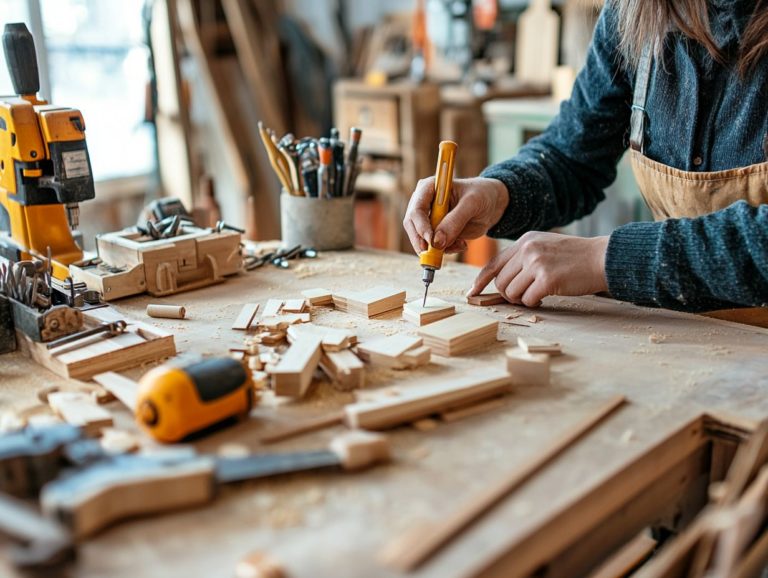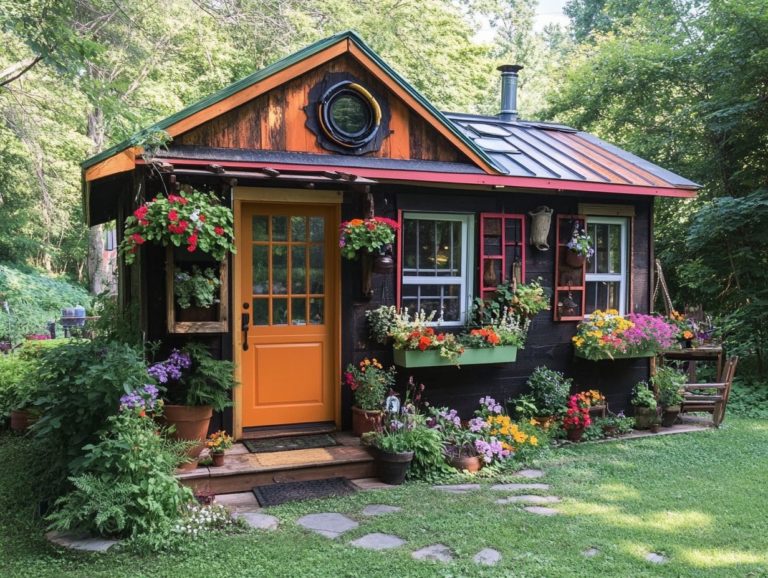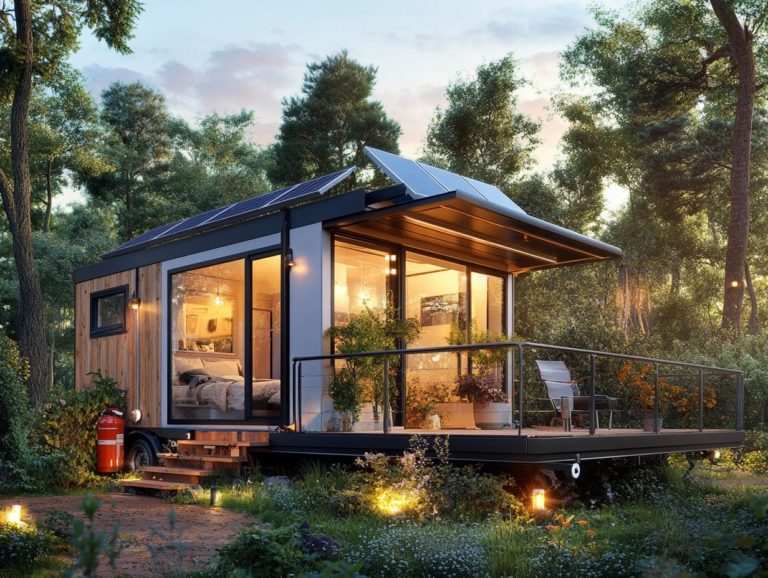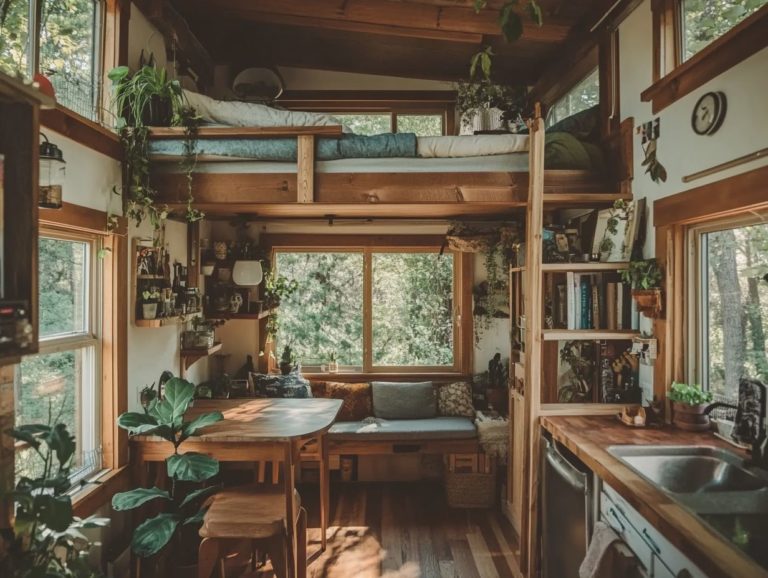The Best DIY Materials for Tiny House Projects
Tiny houses have captured your imagination, offering a minimalist lifestyle that allows you to downsize without sacrificing comfort.
If you’re contemplating a DIY tiny house project, this guide is an invaluable resource at your fingertips. Dive into the world of tiny houses! You can find significant cost savings and the freedom to personalize your space to your liking.
You’ll learn how to select the right materials, with a particular focus on wood options, as well as crucial elements like insulation and roofing. You can find tips for sourcing quality materials without breaking the bank.
Dive in and discover how to create your dream tiny home!
Contents [hide]
- Key Takeaways:
- Benefits of DIY Tiny House Projects
- Choosing the Right Materials for Your Tiny House
- Wood as a Primary Material for Tiny House Projects
- Other Essential Materials for Tiny House Construction
- Tips for Sourcing and Working with DIY Materials
- Frequently Asked Questions
- What are the best DIY materials for tiny house projects?
- How can reclaimed wood be used in tiny house projects?
- Why is plywood a recommended material for tiny house projects, especially in the context of modular design?
- What makes metal roofing a good choice for tiny house projects?
- How can insulation benefit a tiny house project?
- Why is vinyl flooring popular for tiny houses?
Key Takeaways:
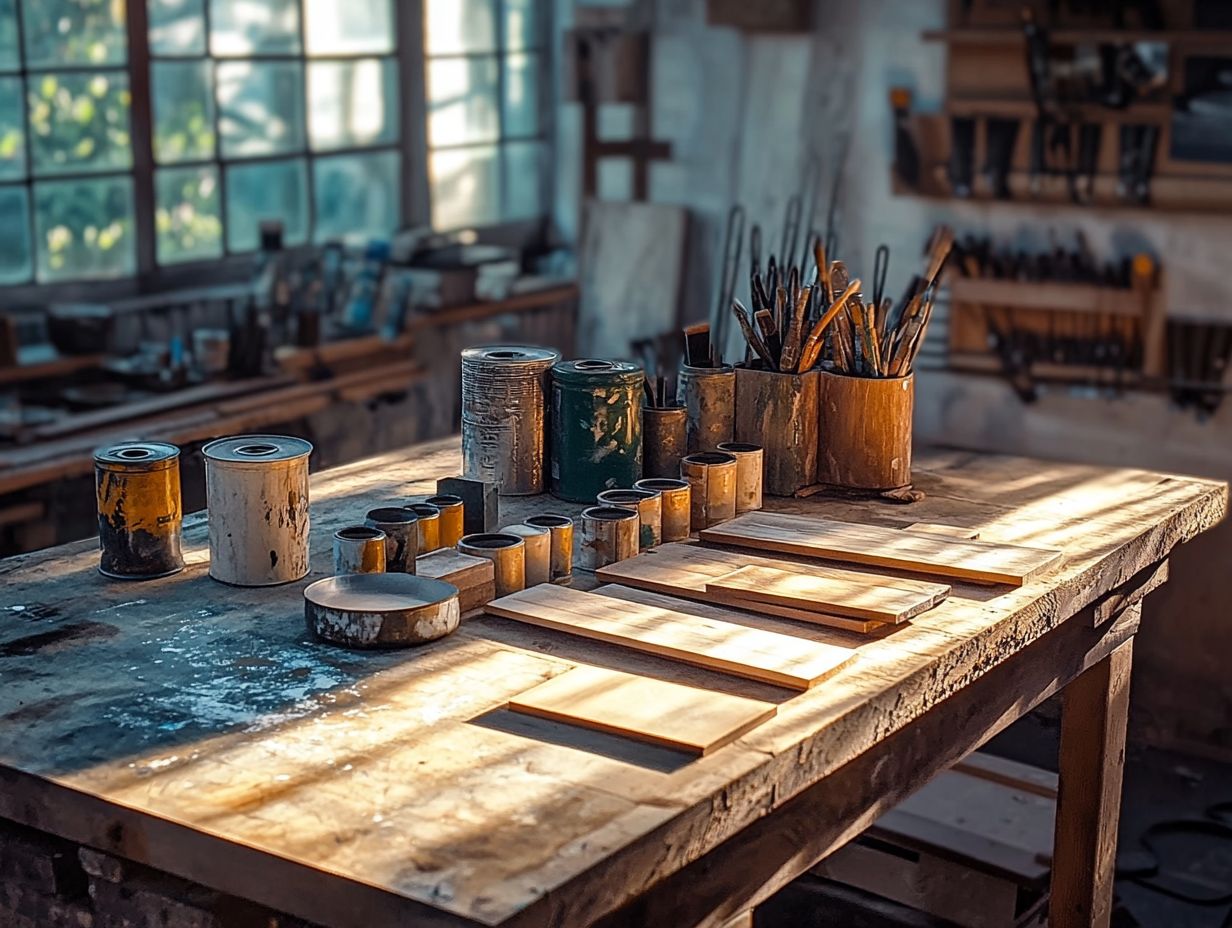
- Save money and add personal touches by using DIY materials for your tiny house construction.
- Consider factors like durability, weight, and cost when choosing the best materials for your tiny house.
- Wood, insulation, roofing, and flooring are essential materials for building a sturdy and comfortable tiny house.
What is a Tiny House?
A tiny house is your ticket to a compact dwelling that maximizes space and functionality, which helps you live sustainably and embrace minimalism. Typically ranging from 100 to 400 square feet, these homes offer a distinctive approach to homeownership, emphasizing affordability and environmental awareness.
With a focus on recycled or sustainable materials and innovative designs, tiny homes have become increasingly popular among those of you seeking a simpler, more intentional lifestyle perfect for reducing your impact on the environment. For inspiration on enhancing your space, check out these tips for DIY tiny house exterior makeover.
More people are becoming interested in sustainable living, and you might find yourself enchanted by the charm and practicality of these minimalist homes. Tiny houses aren t just about downsizing; they represent a new way of thinking, encouraging you to prioritize experiences over possessions.
Thanks to their smaller size, you’ll likely enjoy lower utility costs, making them an attractive option for anyone striving for financial freedom. You’ll also appreciate minimal maintenance, while the community surrounding tiny homes is brimming with connections among like-minded individuals, creating a supportive environment for sharing ideas on eco-friendly practices and innovative living solutions.
This rising trend mirrors a broader cultural shift that values sustainability, simplicity, and a deeper connection to your surroundings.
Benefits of DIY Tiny House Projects
Engaging in DIY tiny house projects gives you the power to have creative control over your living space while unlocking substantial cost savings and personalized design elements. By choosing the DIY route, you have the chance to choose budget-friendly materials, manage labor expenses, and fully customize your tiny home to reflect your unique style and needs.
This customization is a vital aspect of the tiny house movement, allowing you to create a space that truly feels like your own. Exploring the best natural insulation options for tiny houses can further enhance your personalized living experience.
Cost Savings and Personalization
One of the most captivating aspects of DIY tiny houses for you is the perfect fusion of cost savings and personalization. Designing a home that aligns with your unique preferences means you can harness budget-friendly materials while enjoying the creative freedom to craft a space that reflects your style and values.
For example, the choice of using reclaimed wood for flooring or pallets for furniture not only keeps costs down but also infuses your home with distinctive textures and rich stories. You’ll likely uncover a treasure trove of opportunities in thrift stores or online marketplaces, where eclectic items await to complement your aesthetic sensibilities. Additionally, exploring the best resources for sustainable tiny house materials can further enhance your project.
Engaging in projects like building shelves or accent walls from leftover materials fosters a genuine sense of ownership and pride. Each decision you make, whether it involves selecting vibrant paint colors or incorporating sustainable features, gives you the power to shape an environment that truly resonates with your identity. For those considering construction options, exploring the best materials for tiny house construction can enhance this journey. This transforms the tiny home experience into a deeply personal journey that reflects who you are.
Choosing the Right Materials for Your Tiny House
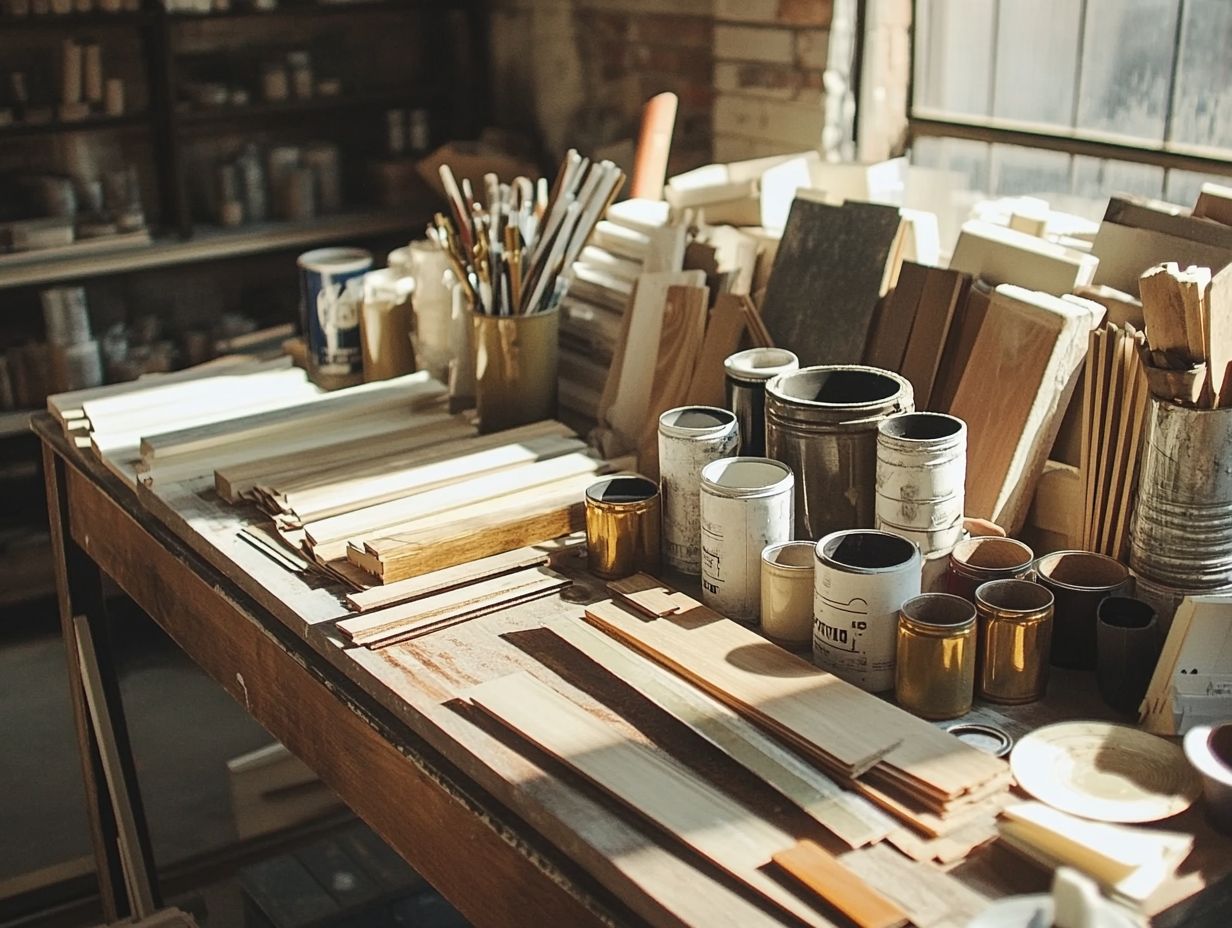
Choosing the right materials for your tiny house is crucial. It can create a stunning, functional, and sustainable living space.
Embracing sustainable living, you can choose energy-efficient options such as insulated panels or reclaimed wood, all while keeping an eye on your budget.
Prefabricated homes provide innovative material solutions, streamlining the building process and ensuring both structural integrity and design flexibility.
With thoughtful choices, you can create a space that reflects your values and meets your needs.
Factors to Consider
Several critical factors affect your material selection. Consider design criteria, building codes, and zoning regulations. Zoning regulations dictate how land can be used, ensuring that your tiny house fits within local standards.
Ensuring structural soundness is essential. It guarantees both the durability and safety of your home while adhering to local city regulations.
The aesthetic appeal of your chosen materials should resonate with your personal preferences and the intended use of the space. Functionality remains paramount in tiny home design.
Environmental considerations, such as sustainability and energy efficiency, also play a crucial role in your material choices. They encourage you to explore eco-friendly alternatives that minimize your carbon footprint.
Wood as a Primary Material for Tiny House Projects
Wood stands out as a premier material for your tiny house projects, celebrated for its versatility, aesthetic charm, and sustainability. You have a range of options at your disposal, including reclaimed wood, which can transform both interiors and exteriors into stunning spaces that amplify natural light while minimizing environmental impact.
Wood is also known for its durability. Its user-friendly nature makes it an exceptional choice for DIY enthusiasts eager to craft their own personalized homes with tiny house décor ideas that inspire.
Types of Wood and Their Uses
Various types of wood serve multiple purposes in your tiny house construction, each contributing to the overall structural integrity and aesthetic appeal of your home. Hardwoods (like oak and maple) come from deciduous trees and are denser, while softwoods (like pine) come from coniferous trees and are lighter.
Your choice of wood not only impacts the visual charm of your interiors but also plays a crucial role in long-term durability and energy efficiency. For instance, cedar is often favored for its natural resistance to moisture, making it an ideal option for exterior applications. Meanwhile, bamboo, celebrated for its sustainability, is becoming a popular choice for eco-friendly flooring.
Each type of wood brings unique qualities to the table, whether it s the robustness of walnut or the lightweight nature of fir. This ultimately influences your building s resilience against environmental factors. Incorporating reclaimed wood can add character and a sense of history to your space, all while being an environmentally conscious choice.
Other Essential Materials for Tiny House Construction

Along with wood, you’ll discover a range of essential materials that are crucial for tiny house construction, including insulation options, roofing, flooring, and appliances. Each of these elements significantly contributes to the efficiency and comfort of your home.
Consider integrating eco-friendly materials, such as recycled and sustainable products, into these areas. This approach elevates the quality of your tiny home while minimizing its environmental footprint. Ensure that you can achieve high-quality finishes without compromising your values.
Insulation, Roofing, and Flooring Options
When choosing insulation, roofing, and flooring for your tiny house, it s important to focus on energy-efficient materials. These materials enhance your comfort while keeping utility costs low. Proper insulation regulates temperature and maximizes natural light throughout your home. Durable roofing and flooring options ensure longevity and visual appeal.
You’ll find various insulation types, such as spray foam, fiberglass, and cellulose. Each has distinct advantages tailored to different climates and budgets. Choosing the right insulation can lead to significant energy savings, resulting in a smaller carbon footprint and lower energy bills.
For roofing, consider materials like metal, shingles, or eco-friendly alternatives. Options including recycled materials elevate your tiny house’s style while protecting against the elements. They also promote efficient drainage and energy recovery. Additionally, exploring unique flooring options for tiny houses can enhance your living space.
When it comes to flooring, consider eco-friendly options like bamboo or cork. These materials provide comfort underfoot and align with sustainable practices. By integrating these elements, you can enhance the overall design of your tiny home, creating a harmonious living space that reflects an environmentally conscious lifestyle. For more insights, explore the future of sustainable materials in tiny housing.
Tips for Sourcing and Working with DIY Materials
Sourcing and working with high-quality DIY materials for your tiny house can greatly influence your budget and the final product’s quality. Explore options like local Habitat ReStores and reclaimed wood to save money while acquiring sustainable living materials that align with your design vision.
It s also important to understand labor and construction costs. Managing these effectively is crucial for your DIY building journey and can incorporate creative solutions.
Saving Money and Ensuring Quality
You can save money and maintain top quality with these exciting strategies! By carefully selecting high-quality materials and choosing energy-efficient options, you can cut construction costs without sacrificing your tiny home’s integrity.
One smart approach is to purchase materials during seasonal sales or at local clearance events. This can lead to remarkable savings. Exploring reclaimed or upcycled materials not only adds unique character to your design but also keeps your expenditures in check. Additionally, considering the future of sustainable materials in tiny housing can further enhance your project.
Incorporate energy-efficient features like solar panels and LED lights to lower your ongoing operational costs. This way, you ll create a sustainable living space that emphasizes the importance of natural lighting, aligning with your aesthetic vision while respecting your budget.
Ultimately, by making intelligent choices, you strike a balance between economy and quality. This ensures lasting satisfaction with your completed project.
Frequently Asked Questions

What are the best DIY materials for tiny house projects?
The best DIY materials for tiny house projects include reclaimed wood, plywood, metal roofing, insulation, and vinyl flooring. These materials are durable, affordable, and easy to work with.
How can reclaimed wood be used in tiny house projects?
Reclaimed wood is a popular choice for tiny house projects as it adds a unique and rustic touch to the design. It can be used for flooring, walls, and furniture.
Why is plywood a recommended material for tiny house projects, especially in the context of modular design?
Plywood is a cost-effective and versatile material that can be used for various purposes in tiny house projects. These include interior siding and custom furniture, making it ideal for creative control.
Start your tiny house journey today and choose the right materials for a sustainable lifestyle!
What makes metal roofing a good choice for tiny house projects?
Metal roofing is lightweight and durable. It withstands harsh weather and fits various tiny house designs.
How can insulation benefit a tiny house project?
Insulation keeps your home cozy. It enhances energy efficiency, reduces noise, and prevents moisture buildup.
Why is vinyl flooring popular for tiny houses?
Get ready to transform your tiny house with budget-friendly vinyl flooring that s both stylish and practical! Its water-resistant properties make it perfect for bathrooms and kitchens.

